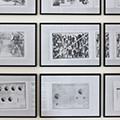Jan Nálevka - And now let’s finally turn the page
Fait Gallery, Ve Vaňkovce 2, Brno
May 23, 2018 - August 4, 2018
|
Jan Nálevka - And now let’s finally turn the pageFait Gallery, Ve Vaňkovce 2, BrnoMay 23, 2018 - August 4, 2018
curator: Jiří Ptáček
exhibition architect: Tomáš Džadoň
A grid becomes a symbol of organisation in the most general sense of the word, a kind of order of things, and at a symbolic level also a world order. - Jan Nálevka The A4 format paper is the most widespread kind of paper in both households and offices. We use it to print ordinary documents, for photocopying, notes and sketches. It is also used for the printing of formal court decisions, meals of the day in cheap restaurants and university theses, as it is the only format with which one can be sure that the diploma work will be bound in covers imitating leather as late as an hour before the deadline. Files for this size are available from any stationery shop, and millions of sheets pile up in millions of metres of office archives. Text editors now offer the digital version of A4… The standardized A4 format is guaranteed by the ISO 216 international standard for paper of the A, B and C categories. The first attempts at standardisation go back to France during the Revolution in the late 18th century. The main advantage of this proportion of sides is the simple division in halves after which the sheets retain the same proportion of sides. The major benefit of the adoption and dissemination of the standard was its compatibility and coordination of the manufacture of a whole spectrum of products. Nowadays, when you ask someone to picture a “common sheet of paper”, they will most probably visualize paper of the A4 format. When lining A4 sheets, Jan Nálevka adjusts the drawing to the standard. He opts for a neutral handwriting, and steps back as an artist. He uses blue ballpoint pens in order to emphasise office work where the compliance with prescribed administration procedures is essential. Reams of paper covered in lines and square grids are virtually indiscernible from mass-produced prints. And since Nálevka further segments the paper with lines and square grids, while in fact still preparing it for writing and drawing, he can talk about the creation of “standardised blankness”, a blankness achieved through work. Its volume, as well as the time it requires, are not proportionate to the result. However, in their reflection there is always space to realise the absurd nature of this activity. Nálevka’s drawings can thus be considered implicitly critical, yet at a more general level they are abstract visualizations of an order introduced into art, or into a work activity as such. And in its ultimate form, the segmented A4 paper format is a symbolic representative of standards predestining our factual possibilities, shaping our perception and behaviour, and providing a basis for our imagination in the private and social dimension of life. The And now, finally, let’s finally turn the page exhibition can be understood as a public audit due to which the material that in the previous decade had progressively emerged at preliminary, autonomous and semi-autonomous presentations was gathered in a single place. And although the show exclusively presents drawings from the years 2009—2018, it captures Nálevka’s thinking concerning the external conditions of the organisation of human life. It is divided into three basic sections. The first one observes the subjects of the basic organisation plan and “standardised blankness” as the consequences of the adopted art-work load. In the second section, the issue of the time invested in the drawings, and lost, comes to the fore. Finally, in the last section Nálevka abandons the point of view of an individual and with plans drawn over reproductions of books on modernist art comments on the historical and possible future social orders.
|


